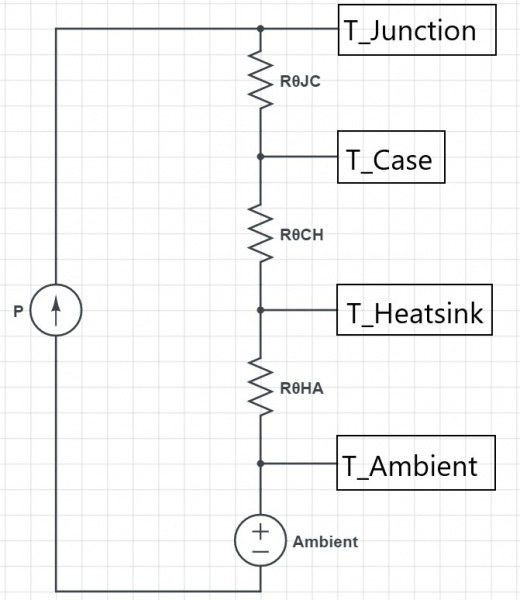Understanding Thermal Resistance
Thermal Resistance
To understand how power losses affect the heat generated, you first need to understand Thermal Resistance (Rθ). Similar to how electrical resistance resists the flow of current in ohms, thermal resistance resists the flow of heat in Kelvins per watt, or in degrees Celsius per watt. We can use thermal resistance to estimate how hot a particular part might get under various loads based on how easily the heat is able to be transfered from one place to another. For electronics the heat starts at the source, such as a semiconductor junction, and spreads to be eventually dissipated to ambient air.
If the junction of a semiconductor exceeds its maximum temperature it will break and let all the magic smoke out. To make sure we don't do that, we need to look at how efficiently the device is able to use the power.....
Ohm’s Law and Thermal Resistance
We can use ohm’s law to calculate the temperatures from the heatsink to the junction, and everywhere in between using Ohm’s Law. As mentioned earlier, electrical resistance is very similar to thermal resistance. We can use Ohm’s Law which states that V = I*R, and replace the voltage for temperature (T) and current for power (P), which gives us:
The equivalent thermal circuit is shown below where:
- T_Junction (TJ): the junction temperature
- RθJC:the junction to case thermal resistance
- T_Case (TC): the junction temperature
- RθCH: the case to heatsink thermal resistance
- T_Heatsink (TH): the heatsink temperature
- RθHA: the heatsink to ambient air thermal resistance
- T_Ambient (TA): the ambient air temperature
To better understand how thermal resistance is used, lets look at the following example:
- Power dissipated: 2W
- RθJC = 4°C/W
- RθCH = 0.25°C/W
- RθHA = 6°C/W
- TA = 25°C
Starting with the thermal equivalent of Ohm's Law:
We want to solve for our junction temperature rise , so T becomes TJ. Our power dissipated, P, is 2W. And our thermal resistances are in series, so just like resistors in series in a circuit we can add the values together:
The junction temperature is 20.5°C above ambient temperature (25°C in this case), which means the absolute temperature is 20.5°C + 25°C, which would be 45.5°C.
Where do you find the thermal resistance values? For parts like voltage regulators, diodes, transistors, and other semiconductors, the datasheet will have a section for the thermal information, mainly the Junction to Air (RθJA) if some type of heatsink weren't used, or Junction to Case (RθJC) if a heatsink was going to be used, which would have its own thermal resistance and is covered in the next section. The typical thermal resistance data would look similar to the image below.



